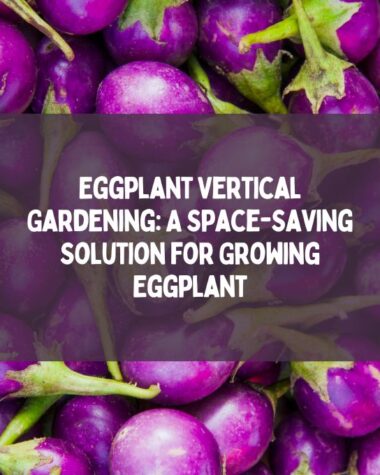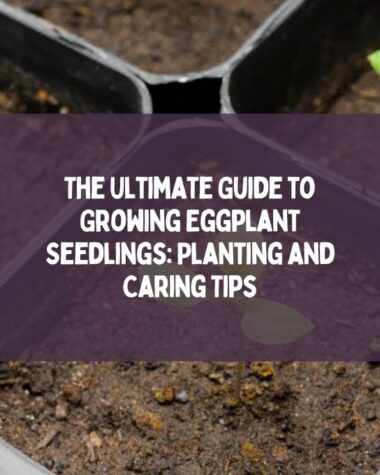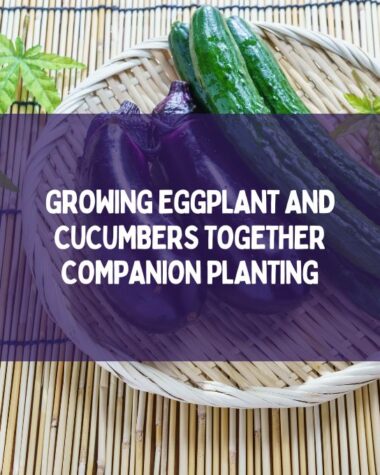Square foot gardening is a popular method of growing vegetables and herbs in a limited space. This technique involves dividing the garden bed into small, equal-sized square sections, each planted with a different crop. One such crop that can be grown successfully in a square-foot garden is eggplant.
Eggplants are a popular vegetable in many cuisines and are a great addition to any home garden. They are a good source of vitamins and minerals, including potassium, fiber, and folate. Growing eggplants in a square-foot garden can help maximize yields and make the most of limited space.
Mel Bartholomew first introduced the concept of square foot gardening in his book, “Square Foot Gardening,” published in 1981. Since then, this gardening method has gained popularity worldwide as a simple, efficient, and sustainable way of growing vegetables and herbs.
In this guide, I will provide all the information you need to know to grow eggplants in your square-foot garden. I will cover everything from choosing suitable soil, selecting the right variety of eggplant, planting and caring for your eggplants, to harvesting and storing your crops. So let’s get started!
Square Foot Gardening
Square foot gardening is a method of gardening that involves dividing a garden bed into small, equal-sized squares, typically measuring 1 foot by 1 foot. Each square is then planted with a different crop. Maximizing the use of space and allowing for a diverse range of vegetables and herbs to be grown in a limited area.
This gardening method is suitable for outdoor and indoor spaces, making it a versatile option for gardeners with limited space or those who want to grow their produce at home.
Benefits of Square Foot Gardening
There are many benefits to square-foot gardening, including:
- Efficient use of space: By dividing the garden into small, equal-sized squares, the space is used efficiently, and each square can be planted with a different crop.
- Reduced water usage: Square foot gardening can reduce water usage as each square is watered individually, reducing water waste.
- Easy maintenance: Square foot gardening is easy to maintain as each square is tended to individually, allowing for better weed control and easier crop management.
- Increased yields: By planting in small squares and maximizing the use of space, square-foot gardening can increase yields compared to traditional gardening methods.
How to Start a Square Foot Garden?
To start a square-foot garden, you will need the following materials:
- Garden bed: You can use any container or raised bed to create your garden.
- Soil: Use a high-quality soil mix that is suitable for vegetable gardening.
- Seeds or seedlings: Choose your favorite vegetable and herb varieties to plant in your garden.
- Measuring tape or ruler: You must divide your garden bed into equal squares.
- String or twine: Use this to create a grid to divide the garden bed into squares.
Planning a Square Foot Garden for Eggplant
To plan your square-foot garden for eggplant, you’ll need to consider the following:
- Variety: Choose a variety of eggplant suitable for the size of your garden bed and check for the climate in your area.
- Spacing: Each square can typically accommodate one eggplant plant, so plan accordingly based on the size of your garden bed.
- Companion planting: Consider companion planting with herbs and other vegetables compatible with eggplants, such as basil, peppers, and tomatoes.
Following these tips, you can grow eggplant in your square-foot garden and enjoy a bountiful harvest of fresh, delicious produce.
Related Read
- How To Harvest Cucumbers In Containers?
- Can You Grow Pumpkins In Containers?
- How Big Of A Pot For Tomatoes? Ideal Container Size For Tomato Plants
Why Grow Eggplant in Square Foot Gardens?
There are several benefits to growing eggplant in a square-foot garden:
- Space efficiency: Eggplant plants can take up a lot of space in a traditional garden bed. However, by growing eggplants in a square-foot garden, you can maximize the use of space and grow more plants per square foot.
- Better yields: Square-foot gardening allows for better plant spacing, which can lead to higher yields of eggplants compared to traditional gardening methods.
- Reduced weed growth: Planting in small, defined squares makes it easier to control weeds and prevent them from choking out your eggplants.
- More efficient watering: With square-foot gardening, each square is watered individually, reducing water waste and ensuring that your eggplants receive the right amount of water.
Comparison of Square Foot Gardening with Traditional Gardening Methods
Traditional gardening typically involves planting vegetables in long rows with wide spacing between plants. This method can lead to less efficient use of space and lower yields. In contrast, square-foot gardening allows for maximum use of space, higher plant density, and better yields.
Factors to Consider When Growing Eggplant in Square Foot Gardens
When growing eggplant in a square-foot garden, there are several factors to consider:
- Variety selection: Choose a variety of eggplant suitable for the size of your garden bed and check for the climate in your area.
- Soil quality: Eggplants require well-draining soil rich in organic matter, so be sure to use a high-quality soil mix.
- Plant spacing: Each eggplant plant typically requires one square foot of space. Be sure to plan accordingly based on the size of your garden bed.
- Fertilization: Eggplants require regular fertilization throughout the growing season. Consider using a slow-releasing fertilizer or compost to keep your plants healthy and productive.
By considering these factors and following good square-foot gardening practices, you can successfully grow eggplant and enjoy a bountiful harvest of fresh, delicious produce.
Also, Read
- The Ultimate Guide to Growing Eggplant Seedlings: Planting and Caring Tips
- How To Grow Eggplants In Containers – Aubergine Container Gardening
- Eggplant Vertical Gardening: A Space-Saving Solution for Growing Eggplant
Selection of Eggplant Varieties Suitable for Square Foot Gardening
When selecting eggplant varieties for square-foot gardening, look for compact varieties that only take up a little space. Some suitable varieties for square-foot gardening include:
- Patio Baby: This variety is compact and produces small, tender fruits perfect for grilling or roasting.
- Ichiban: This variety is long and slender, perfect for growing in narrow garden beds.
- Black Beauty: This classic eggplant variety produces large, glossy fruits. Choose a smaller size plant to grow in your square-foot garden.
Preparing the Soil for Planting Eggplant
To prepare the soil for planting eggplant in a square-foot garden:
- Remove any weeds or debris from the garden bed.
- Add compost or aged manure to the soil to improve fertility.
- Mix in a balanced fertilizer, such as a 10-10-10 or 12-12-12, to give the plants essential nutrients.
How to Plant Eggplant in a Square Foot Garden
To plant eggplant in a square-foot garden:
- Measure and divide the garden bed into 1-foot squares using string or twine.
- Dig a small hole in the center of each square and plant a seedling or sow seeds according to the package directions.
- Water the plants thoroughly after planting.
Maintenance and Care of Eggplant in a Square Foot Garden
To maintain and care for eggplant in a square-foot garden:
- Water the plants deeply once a week or as needed, being careful not to overwater.
- Mulch around the plants to conserve moisture and suppress weed growth.
- Fertilize the plants every two to three weeks with a balanced fertilizer.
- Pinch off any side shoots that develop on the plants to promote bushier growth and higher yields.
Pests and Diseases that Affect Eggplant in Square Foot Gardens
Some common pests and diseases that can affect eggplant in square-foot gardens include:
- Flea beetles: These small, black beetles can cause significant damage to eggplant plants. Control with neem oil or insecticidal soap.
- Aphids: These tiny insects can suck the sap from eggplant plants and cause stunted growth. Control with insecticidal soap or a strong spray of water.
- Verticillium wilt: This fungal disease can cause the yellowing of the leaves and wilting of the plant—control by removing and destroying infected plants and rotating crops to a new location each year.
Following these tips and monitoring for pests and diseases, you can successfully grow eggplant in your square-foot garden.
When to Harvest Eggplant in a Square Foot Garden
Eggplants are ready to harvest when they reach their mature size; the skin is shiny and firm. Harvesting quickly is essential, as overripe eggplants can become bitter and harsh.
How to Harvest Eggplant in a Square Foot Garden
To harvest eggplant in a square-foot garden:
- Use pruning shears or a sharp knife to cut the eggplant stem, leaving a small piece attached to the fruit.
- Be careful not to damage the fruit or nearby plants while harvesting.
- Place the harvested eggplants in a basket or container to prevent bruising.
Storing and Preserving Eggplant Harvested from Square Foot Gardens
Eggplants can be stored in the refrigerator for up to a week. To extend their shelf life, you can blanch and freeze them for later use in recipes.
To blanch eggplant
- Wash and slice the eggplant into desired sizes.
- Bring a pot of water to a boil.
- Add the eggplant slices to the boiling water and blanch for 3-4 minutes.
- Remove the eggplant from the boiling water and immediately transfer it to a bowl of ice water to stop cooking.
- Drain the eggplant and place it in a freezer-safe container or bag.
Following these tips, you can harvest and preserve your eggplant from your square-foot garden and enjoy it in various delicious dishes.







